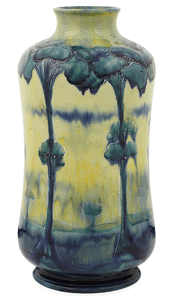|
Ever Popular Moorcroft
| By John Mackie
Decorative Arts Specialist at Lyon & Turnbull Fine Art Auctioneers, Scotland
Posted November 2014
|
 |
|
One of the more successful collecting areas in the Decorative Arts over the last few years has been Moorcroft Pottery. Its strength lies in the consistency achieved in the quality of the decoration and finish of each piece, the wide range of shapes and patterns, and is a testament to the high standards of production and design achieved in the early years of its manufacture. It is also the result of a powerful brand and distinctive style developed by its founder William Moorcroft.
Moorcroft had had a thorough grounding in his chosen field, studying design at the National Art Training School at South Kensington and by 1897 gaining his Art Masters Certificate. His training in the latest principles of design, inspired by William Morris and the Aesthetic Movement, made him the ideal candidate for a post as designer for the firm of Macintyre & Co. in Burslem, Staffordshire in the same year, and by early 1898, he was elevated to the post of Manager of the Ornamental Ware, with its own staff of throwers and decorators.
|

William Moorcroft
|
The explosion of interest in the decorative arts and “home decoration” engendered by followers of the Aesthetic Movement in the late 19th century had led in turn to many pottery companies opening “Art Pottery” departments to take advantage of this trend. Macintyre’s were no exception, and several designers were tried, largely unsuccessfully, before Moorcroft was offered the position in 1898. He quickly developed the production of a new range called Florian Ware, so called to reflect the mainly floral motifs employed, and also reflecting his design principles which favoured decoration drawn from nature. Moorcroft asserted that the designs should follow the form of the vessel, never for their own sake. He was not, as is often assumed, a fan of continental Art Nouveau, and allied himself more to the Arts & Crafts Movement for inspiration; however, the sinuous foliate designs on many of his works have long associated him as an early exponent of that movement in Britain.
|

|

|
|
William Moorcroft (1872-1945) vase for James MacIntyre & Co. in the Cornflower pattern, ca. 1900. Sold at auction by Lyon & Turnbull for £ 3,250. (Image courtesy of Lyon & Turnbull Fine Art Auctioneers.)
|
William Moorcroft Florian ware vase, ca. 1902, for J. MacIntyre & Co. Sold at auction by Lyon & Turnbull for £4,000. (Image courtesy of Lyon & Turnbull Fine Art Auctioneers.)
|
It was at this time that Moorcroft further developed the tube-lining technique his predecessors had started to introduce, where slip is used to boldly decorate the body to form a cloisonné effect, with coloured glazes filling the cells. He was, and continued to be, involved in every step of the throwing, decorating and firing processes, and as a result, he signed each piece himself on the base. The early ranges sold well and were admired for the quality of their decoration and finish. Signing the pieces in this way enabled the Moorcroft name to gain prominence, and the factory was selling internationally, notably at Liberty & Co. London, Tiffany & Co., New York, and at Rouard in Paris.
A friend visiting Tiffany’s in 1907 commented to Moorcroft “... I saw your lustrous new ware. I think it is very fine indeed! All has a label, that shows who is the artist, who is responsible for it. No mentioning the firm’s name at all. Lucky man you are!”
|

|

|
|
Moorcroft vase with fish and flambé glaze, 1930s.
|
A group of wares, 1913-1930s: a tall Florian vase (center) of the type first produced under Macintyre and a later Pomegranate pattern on two plates and mug.
(Photo: Patrick.charpiat.)
|
It may be that the successful promotion of the Moorcroft “brand” and not the reputation of Macintyre & Co. played some part in their decision to close the Art Pottery department by 1913. With characteristic energy, William Moorcroft began to plan a move to a factory of his own and with the backing of Liberty & Co., one of his main outlets, designed and built a brand new factory which was trading the same year. The fact that this factory continues in production to this day is remarkable and owes much to the solid foundations laid down by its founder over a century ago.
--------------------------------------
Lyon & Turnbull, established in Edinburgh in 1826, is Scotland's oldest firm of auctioneers. Visit the website at
www.lyonandturnbull.com.
Endnote: In 1928 through Royal Warrant, Queen Mary made William Moorcroft “Potter to the Queen,” and this title was incised on a backstamp and used on paper labels. (Moorcroft Pottery, Price and Identification Guide 2014, Francis Joseph Publications, p. 14). An interesting video of how Moorcroft pottery is made may be viewed at www.moorcroft.pottery-pieces.com/video.
|